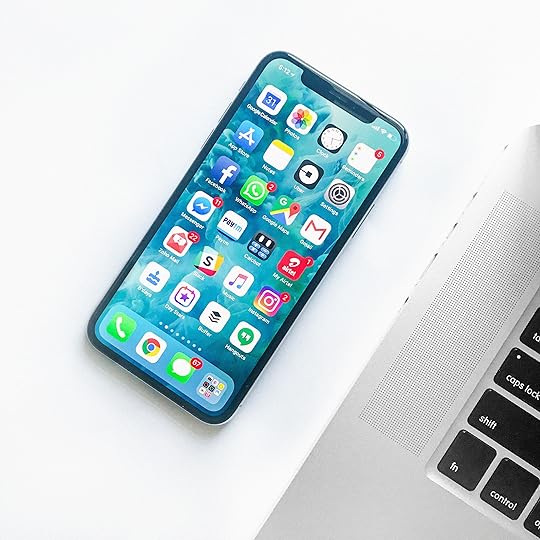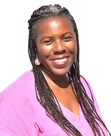Bridgitte Jackson-Buckley's Blog, page 3
June 11, 2019
Mirrors
 Photo by Fares Hamouche on Unsplash
Photo by Fares Hamouche on UnsplashWhen you consider the people around you, it is by no means a coincidence that you find yourself in relationships that are “tailor made” to assist in the development of personal growth based upon total honesty and humble learning. If you look closely at the individuals in your life, it is possible to recognize the complexity of divinely interwoven relationships.
Take a moment to consider the people with whom you work, share a familial or social relationship, or are connected with romantically. Have you ever wondered, on a fundamentally subconscious level, why these people? Why that person? Why are these individuals in my life? Why am I a part of their life?
The feedback you receive from your interactions, and the ways in which you approach the people around you, is constantly revealing something to help you further develop and improve yourself. However, if you are not ready to see what your environment and the people around you reflect back to you, it will not be seen.
As human beings who are more alike than unlike, you are parents, friends, siblings, uncles, aunts, co-workers, grandparents, spousal partners, and nieces and nephews, who are “mirrors” of each other.
The primary purpose of a mirror is to reflect.
The mirror is there for you to look at what is reflected back to you. When you look at your reflection in a mirror, the reflection beckons you to open your eyes to look deeply to see your true reflection; to identify what is not real, what is not truly you so you can let it go.
The reflective mirror also applies to the people in your life.
When you experience these individuals as “mirrors” — the reflections of yourself in another person — they reflect the virtues and qualities you admire in yourself as well as the shortcomings and qualities you reject. What you see outside of yourself and dislike in someone else, is an aspect of yourself which you have not embraced within yourself. The same applies to what you see in someone else that you like or admire. It is an aspect of yourself which you have embraced.
The people in your life also reflect your deepest beliefs, even the beliefs you did not choose.
We all have aspects of ourselves that we want to hide from, be separate from, reject and avoid. These aspects are easy to identify because you judge them and attach negative labels to them. You may label some people as: lazy, controlling, demanding, moody, emotionally unavailable, shameful or too aggressive to name a few. You may label without hesitation to examine where, when, how and to whom you may exhibit the exact same qualities and behaviors.
The people around you are there to show you which qualities to hold onto and which qualities to let go. Their presence in your life can also bring to your attention the importance of not pushing away what is there to embrace.
In their own way each person is in your life to help you remember who you are, just as you do the same for them.
It is the desire and willingness to learn from the people around you that creates the experience for learning. However, due to the possibility of a flawed perspective as garnered through the lack of objectivity, there is a caveat. When you look at the “mirrors” in your life, you can choose to see only what you want to see. It is only when you sincerely make an effort to see yourself reflected back at you when you come to understand there is no need to take anything personally, dole out blame, sit in judgment, or render yourself a victim, because when you are ready to see, you will see.
Keep in mind, you are human, and there may be occasions when you do take something personally, dole out blame or sit eagerly in judgment. However, you can still take steps, no matter how tiny, to transform the relationship with the energy and the individual.
While employed on the research project, it was a pleasant work experience. I worked with a small group of people who were each efficient, professional and interested in doing good work of integrity. We all got along well. There were no major inter-relational problems, office feuds or anything of the sort. However, there was one co-worker who served as the project and budgetary supervisor on the secondary project which corresponded with our main project.
At the time, the secondary project supervisor was a younger graduate student. As the budget technician for both main and secondary projects, I worked with her for project budgetary items.
For the most part, she and I got along well. When we held meetings between the two of us, we conducted business in a polite but relatively cold manner. Without having had a verbal discrepancy or disagreement, it was clear, on a rather quiet level, there was distance between us.
When she made requests, I often responded with doing only what I was asked and nothing more. During office social events, our conversations were routinely forced and guarded, and I noticed we rarely sat at the same table for lunch.
One morning, she came into my office to go over budgetary expenses related to the secondary project. While she sat across the desk in front of me, I thought, ‘She bothers me. She’s cold and guarded.”
Later that evening, while standing at the kitchen sink washing after dinner dishes, the secondary project manner was still on my mind. Something about her gnawed at me. ‘Why does she irritate me so much? What is it about her?’
I scrubbed the pan, and stood quietly with the warm water running over my hands. Out of nowhere, or perhaps from a residual self-help book memory, a thought seeped through. I looked up and out the window, and stood completely still staring into the backyard at nothing.
‘She is cold and guarded, and so am I.’
For as long as I live, I will never forget the impact of that single “aha moment”. The revelatory insight was astounding.
She was the mirror of internal qualities I disowned and rejected within myself. The strong emotional response I felt towards her was simultaneously the trigger and the gift. My response let me know exactly what I needed to look at within myself.
 Photo by Blake Barlow on Unsplash
Photo by Blake Barlow on UnsplashFrom that moment on, the course of our interactions completely changed for the better. The resistant energy, which was normally present, when she made a perfectly appropriate business request lessened. Going forward during our budgetary meetings, I was able to sit across from her at my desk and see her from a softer non-judgmental place. I no longer held her at a distance. There was no need for emotional agitation.
Once I recognized what was going on, what I projected onto our interactions, the energy around our interactions and my thoughts about her shifted. The contempt I once felt was now replaced with compassion for her and for myself.
It is from the relationships with family members, friends, colleagues, and especially those who “push” your emotional buttons, that you are encouraged to look at who you are so you can plant a different “seed” in your collective lineage of relationships.
Relationships provide an opportunity for you to heal emotional wounds and self-negating beliefs at the level where you are, so you don’t take them with you where you want to go.
There is a wide reach of individuals from whom we can learn. When you are ready, you will become aware of “teachers” and “mirrors” who can show you where the next stage of healing is ready to occur.
Excerpt from The Gift of Crisis: How I Used Meditation to Go From Financial Failure to a Life of Purpose.

The Teacher in the Mirror
When you consider the people around you, it is by no means a coincidence that you find yourself in relationships that are “tailor made” to assist in the development of personal growth based upon total honesty and humble learning. If you look closely at the individuals in your life, it is possible to recognize the complexity of divinely interwoven relationships.
Take a moment to consider the people with whom you work, share a familial or social relationship, or are connected with romantically. Have you ever wondered, on a fundamentally subconscious level, why these people? Why that person? Why are these individuals in my life? Why am I a part of their life?
The feedback you receive from your interactions, and the ways in which you approach the people around you, is constantly revealing something to help you further develop and improve yourself. However, if you are not ready to see what your environment and the people around you reflect back to you, it will not be seen.
As human beings who are more alike than unlike, you are parents, friends, siblings, uncles, aunts, co-workers, grandparents, spousal partners, and nieces and nephews, who are “mirrors” of each other.
The primary purpose of a mirror is to reflect.
The mirror is there for you to look at what is reflected back to you. When you look at your reflection in a mirror, the reflection beckons you to open your eyes to look deeply to see your true reflection; to identify what is not real, what is not truly you so you can let it go.
The reflective mirror also applies to the people in your life.
When you experience these individuals as “mirrors” — the reflections of yourself in another person — they reflect the virtues and qualities you admire in yourself as well as the shortcomings and qualities you reject. What you see outside of yourself and dislike in someone else, is an aspect of yourself which you have not embraced within yourself. The same applies to what you see in someone else that you like or admire. It is an aspect of yourself which you have embraced.
The people in your life also reflect your deepest beliefs, even the beliefs you did not choose.
We all have aspects of ourselves that we want to hide from, be separate from, reject and avoid. These aspects are easy to identify because you judge them and attach negative labels to them. You may label some people as: lazy, controlling, demanding, moody, emotionally unavailable, shameful or too aggressive to name a few. You may label without hesitation to examine where, when, how and to whom you may exhibit the exact same qualities and behaviors.
The people around you are there to show you which qualities to hold onto and which qualities to let go. Their presence in your life can also bring to your attention the importance of not pushing away what is there to embrace.
In their own way each person is in your life to help you remember who you are, just as you do the same for them.
It is the desire and willingness to learn from the people around you that creates the experience for learning. However, due to the possibility of a flawed perspective as garnered through the lack of objectivity, there is a caveat. When you look at the “mirrors” in your life, you can choose to see only what you want to see. It is only when you sincerely make an effort to see yourself reflected back at you when you come to understand there is no need to take anything personally, dole out blame, sit in judgment, or render yourself a victim, because when you are ready to see, you will see.
Keep in mind, you are human, and there may be occasions when you do take something personally, dole out blame or sit eagerly in judgment. However, you can still take steps, no matter how tiny, to transform the relationship with the energy and the individual.
While employed on the research project, it was a pleasant work experience. I worked with a small group of people who were each efficient, professional and interested in doing good work of integrity. We all got along well. There were no major inter-relational problems, office feuds or anything of the sort. However, there was one co-worker who served as the project and budgetary supervisor on the secondary project which corresponded with our main project.
At the time, the secondary project supervisor was a younger graduate student. As the budget technician for both main and secondary projects, I worked with her for project budgetary items.
For the most part, she and I got along well. When we held meetings between the two of us, we conducted business in a polite but relatively cold manner. Without having had a verbal discrepancy or disagreement, it was clear, on a rather quiet level, there was distance between us.
When she made requests, I often responded with doing only what I was asked and nothing more. During office social events, our conversations were routinely forced and guarded, and I noticed we rarely sat at the same table for lunch.
One morning, she came into my office to go over budgetary expenses related to the secondary project. While she sat across the desk in front of me, I thought, ‘She bothers me. She’s cold and guarded.”
Later that evening, while standing at the kitchen sink washing after dinner dishes, the secondary project manner was still on my mind. Something about her gnawed at me. ‘Why does she irritate me so much? What is it about her?’
I scrubbed the pan, and stood quietly with the warm water running over my hands. Out of nowhere, or perhaps from a residual self-help book memory, a thought seeped through. I looked up and out the window, and stood completely still staring into the backyard at nothing.
‘She is cold and guarded, and so am I.’
For as long as I live, I will never forget the impact of that single “aha moment”. The revelatory insight was astounding.
She was the mirror of internal qualities I disowned and rejected within myself. The strong emotional response I felt towards her was simultaneously the trigger and the gift. My response let me know exactly what I needed to look at within myself.
 Photo by Blake Barlow on Unsplash
Photo by Blake Barlow on UnsplashFrom that moment on, the course of our interactions completely changed for the better. The resistant energy, which was normally present, when she made a perfectly appropriate business request lessened. Going forward during our budgetary meetings, I was able to sit across from her at my desk and see her from a softer non-judgmental place. I no longer held her at a distance. There was no need for emotional agitation.
Once I recognized what was going on, what I projected onto our interactions, the energy around our interactions and my thoughts about her shifted. The contempt I once felt was now replaced with compassion for her and for myself.
It is from the relationships with family members, friends, colleagues, and especially those who “push” your emotional buttons, that you are encouraged to look at who you are so you can plant a different “seed” in your collective lineage of relationships.
Relationships provide an opportunity for you to heal emotional wounds and self-negating beliefs at the level where you are, so you don’t take them with you where you want to go.
There is a wide reach of individuals from whom we can learn. When you are ready, you will become aware of “teachers” and “mirrors” who can show you where the next stage of healing is ready to occur.
Excerpt from The Gift of Crisis: How I Used Meditation to Go From Financial Failure to a Life of Purpose.

May 20, 2019
The Game Plan
April 21, 2019
The Planet Earth Series
April 14, 2019
Hi Christina, people love to hear the story behind the story.
Hi Christina, people love to hear the story behind the story. I’ve found that personal stories really enhance the feel of the event. I’m sure you have some good ones!

April 10, 2019
Find Your Inner Rumi
April 8, 2019
Michele, don’t forget to have fun and just be yourself!!
Michele, don’t forget to have fun and just be yourself!! It’s SOOO exciting to talk about your book with readers!

April 5, 2019
I can relate to this more than you could ever know.
I can relate to this more than you could ever know.

April 2, 2019
March 29, 2019
What You Can Learn from a Physical Experience of Your Thoughts
 Photo by Mohamed Nohassi on Unsplash
Photo by Mohamed Nohassi on UnsplashThoughts and emotions have a direct effect on the physical experience of your body. To put it simply, what we think not only impacts how we feel but also what we feel.
According to The Completion Process, “Because of the emotional body, you are able to physically experience your own thoughts. First, your thoughts are converted into feeling impressions. Then your physical body interprets those feelings, as if translating a message, and converts those feeling states into neuropeptides and hormones. These elements cause the physical reactions in your body called “emotions.” Emotions range from fear, anger, and stress to love, compassion and happiness.”
“The feeling body is the translator between physical experience and non-physical experience. It’s what makes you able to experience thought as something “real.” If your sense of life is painful, and if the conclusions you’ve drawn about life are painful, and if memories are painful then your feeling body will continue to convey all these painful messages to our physical body.”
A clear example of this is when the opportunity to write a book appeared.
Although it is something I have always wanted to do, when the opportunity surfaced so did the unexpected anxiety ridden thoughts about change in my life and the fear of failure.
I had many fearful thoughts about what I didn’t know about navigating a new literary world and the possibility of not rising to the occasion.
During the week I sat down to write chapter three to include in the book proposal, out of nowhere I experienced a terrible pain in my left shoulder. The pain was so excruciating I could not lift my arm, lie on either side of my body or move my arm in any direction. Prior to the onset of the shoulder pain, I did not sprain my shoulder, I did not lift anything heavy, nor did I fall.
Yet, a few days following a conversation with my literary agent, the pain of a frozen shoulder emerged.
During our conversation, my literary agent told me she would need three solid chapters in the book proposal to send out to potential buyers. Of course, I was excited! However, I was equally nervous. While thinking about completing chapter three, I worried about my writing, how the book will be received, how my life will change in unanticipated ways, and if I will lose all anonymity.
Not only did my frozen shoulder represent a psychosomatic/feeling response to my internal conflict and self-imposed stress, it also represented the fear in my thoughts about imminent change making its way into my life.
Change is an intricate and vital part of life that asks you, and me, to begin again and again to reorient yourself and your thoughts about change. When change happens in your life, because you don’t know what is going to happen, you may also experience the “frozen shoulder”. However, you cannot let the “frozen shoulder” or fear of change stop you from moving forward, just as I could not and did not.
Within a few hours of a candid conversation with a close friend, of voicing out loud what lie beneath my fears, the pain in my shoulder began to dissipate. By the next morning the pain was completely gone.
The good thing about my frozen shoulder episode is, I talked with a trusted friend to quickly identify, verbalize and be with the emotional trigger of what change represented and my unhealthy mental interpretation of change.
The shoulder pain/fear served as an opportunity to see things as they really are through self-observation. Internal guidance and the mind are interwoven within us to help us understand the world outside of us and the vast world within. The idea is for the mind (thoughts) and your body to work with you not against you.
As you move along the path of growth and change an understanding develops to show that if you are aware of your thoughts and emotions, you can choose to change them. You will notice fearful thoughts become less debilitating. You may be momentarily knocked off-balance, but as you become adept at identifying what lies beneath such thoughts you can quickly return to balance.
You can learn to examine your thoughts, experience change with ease and grace, without beating yourself up or running away from what scares you. You can choose to accept what is trying to come to you or through you, even if you’re not sure what it is or where it will lead you.
And lastly, you can learn from the physical experience of your thoughts not to believe everything you think.








